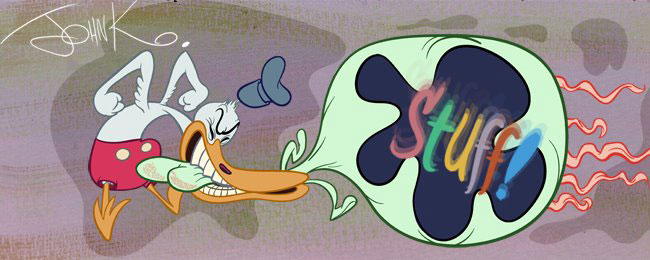
I gave Kali a layout lesson yesterday. Here's just the first drawing I did. It came from this rough below. The first thing I did was block everything out real roughly to make sure I had the line of action and big negative spaces between the main parts of the action- between his body foot and dresser.

Like everyone does, I toned it down a bit, but now that it's all constructed I could easily go back and push the foot and eyes a little more like the rough.
 The Focus of the pose: THE FOOT PUSHING THE DRAWER IN.
The Focus of the pose: THE FOOT PUSHING THE DRAWER IN.The whole pose is made to highlight this action.
 His body leans back. I used a line of action to do that.
His body leans back. I used a line of action to do that. Second in importance to the physical action in the drawing, is his reaction to it. His feeling. His personality. That takes place mostly in the face.
Second in importance to the physical action in the drawing, is his reaction to it. His feeling. His personality. That takes place mostly in the face.I AVOIDED A CRAMPED FACE
Note how I left space between all the important major elements of his face:The eyes.
The nose
The mouth
Some people tend to push all the features together where they get cramped and hard to read.
THE EYES ARE CHEATED FOR EFFECT
Looking at the lucky accident in the rough-where the eye that is further away from us is bigger (which is wrong perspective) I used that to enhance the expression.I made sure the rest of his head and face were in solid construction and perspective, and then gave the eyes cartoon license. I overlapped the farther away eye over the close eye. This exaggerates the impression that the eyes are looking back at us, opposite to his body pose which is facing the dresser.
If I broke the rules all over the drawing and made nothing logical, you wouldn't be drawn to the eyes because nothing would make sense.
NEGATIVE SPACES FOR SILHOUETTE
 To help read the face against the arm I made sure that there was a clear silhouette to the edge of the face. Some shapes push out (muzzle and nose), some indent in - the eye mask area. This indented eye mask area helps him look smug. It helps pull his eye brows up.
To help read the face against the arm I made sure that there was a clear silhouette to the edge of the face. Some shapes push out (muzzle and nose), some indent in - the eye mask area. This indented eye mask area helps him look smug. It helps pull his eye brows up.HOW CHEEKS AND SMILES WORK TOGETHER
 Note that the smile line and cheek line above create a shape (in yellow). The smile is pushing the meat of his cheek up, squeezing the area between. Note also the soft angles curving around the cheek/face area. It isn't a simple circular curve or half oval.
Note that the smile line and cheek line above create a shape (in yellow). The smile is pushing the meat of his cheek up, squeezing the area between. Note also the soft angles curving around the cheek/face area. It isn't a simple circular curve or half oval.CONSTRUCT HAND SHAPES BEFORE DRAWING FINGERS
 His fingers are not doing anything so I keep them contained within the shape of the hand.
His fingers are not doing anything so I keep them contained within the shape of the hand.For organic pseudo-realism, I made the fingers converge towards each other at bottom, rather than be parallel sausages.
 The other hand is just hanging back and those fingers "splay". They aim very slightly apart, also for organicness.
The other hand is just hanging back and those fingers "splay". They aim very slightly apart, also for organicness. I put weight on the foot on the ground by bending the knee and having the lower part of the leg overlap the top of the foot.
I put weight on the foot on the ground by bending the knee and having the lower part of the leg overlap the top of the foot.Also, the top of the foot bulges upwards in the middle, while the bottom part is being squashed flat against the ground.
I kept the toenails compressed together so as not to compete for attention with the other foot that is closing the drawer.

Note the shape created by the space between his foot and arm (in red). It's diagonal, which helps draw attention to the fact that the foot is pushing forward of the body. If the hand had been posed right on top of the foot, it would have eaten away at the focus of the whole pose.
All this is logic and control and is what separates functional drawings from elaborate fancy ass sketchbook doodles.
In order to get functional, you have to do lots and lots of thoughtful planned drawings (as opposed to random doodling in your sketchbooks). Not just one every couple weeks. It's not enough to think you understand the concepts. You have to apply them to make them sink in and eventually become second nature.
Later, I will show you Kali's first try at doing a layout from the scene, my corrections and comments and then her 2nd try where she fixes everything and makes the pose stronger.
OK?
Hey, I have a question. How many people who read the blog are here for the drawing tips?

